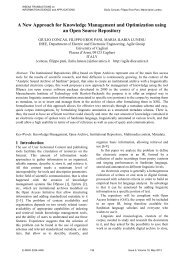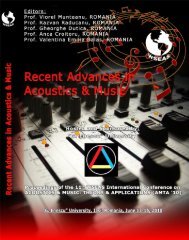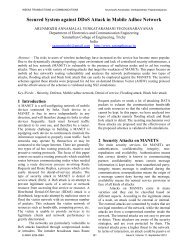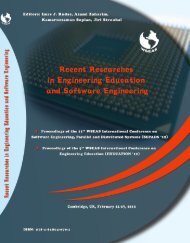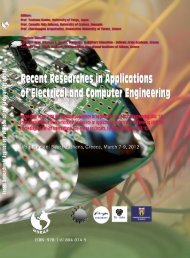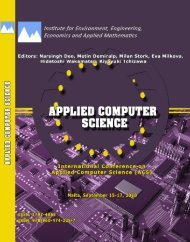ADVANCES in CLIMATE CHANGES, GLOBAL ... - Wseas.us
ADVANCES in CLIMATE CHANGES, GLOBAL ... - Wseas.us
ADVANCES in CLIMATE CHANGES, GLOBAL ... - Wseas.us
- No tags were found...
Create successful ePaper yourself
Turn your PDF publications into a flip-book with our unique Google optimized e-Paper software.
<strong>ADVANCES</strong> <strong>in</strong> <strong>CLIMATE</strong><strong>CHANGES</strong>, <strong>GLOBAL</strong> WARMING,BIOLOGICAL PROBLEMS andNATURAL HAZARDS3rd WSEAS International Conference on <strong>CLIMATE</strong> <strong>CHANGES</strong>,<strong>GLOBAL</strong> WARMING, BIOLOGICAL PROBLEMS (CGB '10)3rd WSEAS International Conference on NATURAL HAZARDS(NAHA '10)University of Algarve, Faro, PortugalNovember 3-5, 2010Published by WSEAS Press ISSN: 1792-6173www.wseas.org ISSN: 1792-619XISBN: 978-960-474-247-9
<strong>ADVANCES</strong> <strong>in</strong> <strong>CLIMATE</strong><strong>CHANGES</strong>, <strong>GLOBAL</strong> WARMING,BIOLOGICAL PROBLEMS andNATURAL HAZARDS3rd WSEAS International Conference on <strong>CLIMATE</strong> <strong>CHANGES</strong>,<strong>GLOBAL</strong> WARMING, BIOLOGICAL PROBLEMS (CGB '10)3rd WSEAS International Conference on NATURAL HAZARDS(NAHA '10)University of Algarve, Faro, PortugalNovember 3-5, 2010Published by WSEAS Presswww.wseas.orgCopyright © 2010, by WSEAS PressAll the copyright of the present book belongs to the World Scientific and Eng<strong>in</strong>eer<strong>in</strong>g Academy andSociety Press. All rights reserved. No part of this publication may be reproduced, stored <strong>in</strong> a retrievalsystem, or transmitted <strong>in</strong> any form or by any means, electronic, mechanical, photocopy<strong>in</strong>g, record<strong>in</strong>g, orotherwise, without the prior written permission of the Editor of World Scientific and Eng<strong>in</strong>eer<strong>in</strong>g Academyand Society Press.All papers of the present volume were peer reviewed by two <strong>in</strong>dependent reviewers. Acceptance wasgranted when both reviewers' recommendations were positive.See also: http://www.worldses.org/review/<strong>in</strong>dex.htmlISSN: 1792-6173ISSN: 1792-619XISBN: 978-960-474-247-9World Scientific and Eng<strong>in</strong>eer<strong>in</strong>g Academy and Society
<strong>ADVANCES</strong> <strong>in</strong> <strong>CLIMATE</strong><strong>CHANGES</strong>, <strong>GLOBAL</strong> WARMING,BIOLOGICAL PROBLEMS andNATURAL HAZARDS3rd WSEAS International Conference on <strong>CLIMATE</strong> <strong>CHANGES</strong>,<strong>GLOBAL</strong> WARMING, BIOLOGICAL PROBLEMS (CGB '10)3rd WSEAS International Conference on NATURAL HAZARDS(NAHA '10)University of Algarve, Faro, PortugalNovember 3-5, 2010
Editors:Thomas Panagopoulos, University of Algarve, PORTUGALInternational Program Committee Members:Joao Guerreiro, PORTUGALTeresa Noronha, PORTUGALEfigenio da Luz Rebelo, PORTUGALLuis Chicharo, PORTUGALJon Bryan Burley, USATomas Boski, PORTUGALLea Orlovsky, ISRAELJose Beltrao, PORTUGALTeresa Andresen, PORTUGALLuis Ribeiro, PORTUGALRui Guerra, PORTUGALInga Straupe, LATVIADulce Antunes, PORTUGALMaria de Belem Mart<strong>in</strong>s, PORTUGALMaria Bostenaru, ROMANIAFelipa Lopes dos Reis, PORTUGALLivia Madureira, PORTUGALNuno P<strong>in</strong>to, PORTUGALCarlos Guerrero, PORTUGALClaud<strong>in</strong>e Metral, SWITZERLANDIoannis Tsalikidis, GREECEC. Helmis, GREECEF. Rigas, GREECEN. Afgan, PORTUGALF. Akgun, TURKEYOmar Badran, JORDANY. Baudo<strong>in</strong>, BELGIUMA. Bitoleanu, ROMANIAL. Boch-Andersen, BELGIUMP. Casero, SPAINE. Frey, GERMANYM. Heiermann, GERMANYA. E. Holdo, UKD. De Keukeleere, BELGIUMM. Versan Kok, TURKEYG. Kolb, DENMARKA. Kurbatskiy, RUSSIAS. L<strong>in</strong>deroth, DENMARKP. Lunghi, ITALYC. Machens, GERMANYA. Midilli, CANADAJ. Van Mierlo, BELGIUMS. Ozdogan, TURKEYM. Reijalt, ITALYJ. Rogut, POLANDI. V. S<strong>in</strong>gh, INDIAE. Smole, AUSTRIAR. Tamme, GERMANYM. Teixeira, PORTUGALR. Vigotti, ITALYG. Wolf, GERMANYG. Wisniewski, POLANDA. Van Zyl, BELGIUMZ. A. Vale, PORTUGALA. F. Zobaa, EGYPTMet<strong>in</strong> Demiralp, TURKEYValeri Mladenov, BULGARIAZoran Bojkovic, SERBIALeon Trill<strong>in</strong>g, USAD. Perk<strong>in</strong>s, USADionysios (Dion) D. Dionysiou, USALeonid Perlovsky, USAKent Davey, USADavid Landgrebe, USASteven H. Collicott, USAMarco Ceccarelli, ITALYJohn W. Lund, USADimitris Bertsekas, USADavid Stael<strong>in</strong>, USAA. Bers, MUSALeon Trill<strong>in</strong>g, USALotfi Zadeh, USALeon Chua, USABrian A. Barsky, USALeonid Kazovsky, USARao Kamissety, USAStamatios Kartalopoulos, USA
PrefaceThis year the 3rd WSEAS International Conference on <strong>CLIMATE</strong> <strong>CHANGES</strong>, <strong>GLOBAL</strong>WARMING, BIOLOGICAL PROBLEMS (CGB '10) and the 3rd WSEAS InternationalConference on NATURAL HAZARDS (NAHA '10) were held at the University of Algarve,Faro, Portugal, November 3-5, 2010. The conferences rema<strong>in</strong> faithful to their orig<strong>in</strong>al idea ofprovid<strong>in</strong>g a platform to disc<strong>us</strong>s climate change factors, variations with<strong>in</strong> the earth's climate, nonclimatefactors driv<strong>in</strong>g climate change, human <strong>in</strong>fluences on climate change, monitor<strong>in</strong>g thecurrent stat<strong>us</strong> of climate, simulation of climate change, climate change and biodiversity,dynamics and stability of ecosystems, natural hazards, crops & drought, conditions that help thespread of vector-borne diseases etc. with participants from all over the world, both fromacademia and from <strong>in</strong>d<strong>us</strong>try.Their success is reflected <strong>in</strong> the papers received, with participants com<strong>in</strong>g from several countries,allow<strong>in</strong>g a real mult<strong>in</strong>ational multicultural exchange of experiences and ideas.The accepted papers of these conferences are published <strong>in</strong> this Book that will be <strong>in</strong>dexed by ISI.Please, check it: www.worldses.org/<strong>in</strong>dexes as well as <strong>in</strong> the CD-ROM Proceed<strong>in</strong>gs. They willbe also available <strong>in</strong> the E-Library of the WSEAS. The best papers will be also promoted <strong>in</strong> manyJournals for further evaluation.Conferences such as these can only succeed as a team effort, so the Editors want to thank theInternational Scientific Committee and the Reviewers for their excellent work <strong>in</strong> review<strong>in</strong>g thepapers as well as their <strong>in</strong>valuable <strong>in</strong>put and advice.The Editors
<strong>ADVANCES</strong> <strong>in</strong> <strong>CLIMATE</strong> <strong>CHANGES</strong>, <strong>GLOBAL</strong> WARMING, BIOLOGICAL PROBLEMS and NATURAL HAZARDSTable of ContentsPlenary Lecture 1: Effects of Global Climate Change on Development and Growth of Crops 11Jose Paulo de Melo-AbreuPlenary Lecture 2: The Contribution of Portuguese Agriculture to the Climate Change andAdaptation Strategies for the SectorCor<strong>in</strong>a Carranca12Landscape Science and Global Environmental Change 13Olav SlaymakerClimate Changes and Their Effects on the Vegetation Recovery <strong>in</strong> the Pre-Aral Region 19Zhanna V. Kuzm<strong>in</strong>a, Sergey E. Treshk<strong>in</strong>Application of Helical and Energetic Characteristics of the Velocity Field to Predict andEvaluate Tropical Cyclones’ Formation and DevelopmentEkater<strong>in</strong>a Glebova25Visual Appearance of Turfgrass under Different Water Regimes 30Manuel Costa, Jose Beltrao, Joao Carrasco De Brito, Carlos GuerreroSalt Remov<strong>in</strong>g Crops <strong>in</strong> Arid Climates 36Gulom Bekmirzaev, Mukhamadkhan Khamidov, Jose Beltrao, Maria Alc<strong>in</strong>da NevesVegetation Changes <strong>in</strong> the P<strong>in</strong>e Forests of the Nature Park Tervete, Latvia 42Inga Straupe, Vija KreileThe Contribution of Portuguese Agriculture to the Climate Change, Mitigation andAdaptation Strategies for the SectorCor<strong>in</strong>a CarrancaThe Agro-Forestry Farms’ Socioeconomic Characterization for a Forest Fire Prevention andManagement ModelAntonio Xavier, Maria De Belem Mart<strong>in</strong>sThe Zonal Interpolation Of Socioeconomic Statistics: An Application of a Dasymetric Mapp<strong>in</strong>gMethodology to the Region of AlgarveAntonio Xavier, Maria De Belem Mart<strong>in</strong>s485764The Climate and History of Algarve – Interactions 70Manuel CostaL<strong>in</strong>ear Infrastructures <strong>in</strong> Complex Landscapes: The Case of A22 Highway, Portugal 76Elena Berte, Thomas PanagopoulosLava Flows Impact Prediction at Mount Etna by Cellular Automata 85Valeria Lupiano, Rocco Rongo, Maria Vittoria Avolio, William SpataroISSN: 1792-6173 / ISSN: 1792-619X 9 ISBN: 978-960-474-247-9
<strong>ADVANCES</strong> <strong>in</strong> <strong>CLIMATE</strong> <strong>CHANGES</strong>, <strong>GLOBAL</strong> WARMING, BIOLOGICAL PROBLEMS and NATURAL HAZARDSSeasonal Fluctuations of the F<strong>in</strong>e Fraction of PM1.0 <strong>in</strong> Urban Conglomerations 91Josef Navratil, Vladimir Adamec, Alena Bumbova, Alena Langerova, Lenka JesonkovaChanges <strong>in</strong> the Structure of Zooplankton Communities <strong>in</strong> the Freshwater Ecosystems <strong>in</strong> Latviaover the Last Five DecadesArturs Skute, Rasma Deksne, Jana Paidere, Natalja Skute, Aija Brakovska96Technology for Decision Support dur<strong>in</strong>g Biological Incidents Responses 101Tereza Otcenaskova, Vladimir Bures, Pavel Cech, Karel AntosThe Effect of PAM (Polyacrilamid) on W<strong>in</strong>d Blown Sand Abrasion Injury and Production ofVegetablesJiftah Ben-Asher, Arthur Genis, Leonid Vulfson105Soil Erodibility Assessment at the Alqueva Dam Watershed, Portugal 112Vera Ferreira, Thomas PanagopoulosCarob-Tree as CO2 S<strong>in</strong>k <strong>in</strong> the Carbon Market 119Daniel Geraldo, Pedro Jose Correia, Jose Filipe, Luis NunesFormation of Agreements on Climate Change: The Impact of Uncerta<strong>in</strong>ty 124Michael F<strong>in</strong><strong>us</strong>, Pedro P<strong>in</strong>tassilgoAuthors Index 130ISSN: 1792-6173 / ISSN: 1792-619X 10 ISBN: 978-960-474-247-9
<strong>ADVANCES</strong> <strong>in</strong> <strong>CLIMATE</strong> <strong>CHANGES</strong>, <strong>GLOBAL</strong> WARMING, BIOLOGICAL PROBLEMS and NATURAL HAZARDSPlenary Lecture 1Effects of Global Climate Change on Development and Growth of CropsProfessor Jose Paulo de Melo-AbreuInstituto Superior de AgronomiaTechnical University of Lisbon (TULisbon)Tapada da Ajuda, 1349-017 Lisboa, PortugalAbstract: The <strong>in</strong>crease of emissions of green ho<strong>us</strong>e gases is chang<strong>in</strong>g the global climate. In most areas of the world,temperature will go on <strong>in</strong>creas<strong>in</strong>g, ra<strong>in</strong>fall patterns will be distorted, absolute humidity will rise, and extreme weatherevents will be likely more frequent and severe. However, the projections that have been published show that theclimates of the vario<strong>us</strong> geographical areas are affected differently. In general, as far as crop performance isconcerned, lower latitudes get the most pernicio<strong>us</strong> effects and higher latitudes tend to have little or no crop loss.Increased carbon dioxide concentration and some of the changes on weather elements will <strong>in</strong>fluence cropdevelopment and growth <strong>in</strong> a simple way, but other reperc<strong>us</strong>sions are more difficult to grasp.Increased carbon dioxide concentration <strong>in</strong> the air augments photosynthetic rate, ma<strong>in</strong>ly of C3 plants. Air temperature<strong>in</strong>creases favour plant development and growth under colder conditions, but may reduce plant performance <strong>in</strong>warmer areas. Higher temperatures may favour the development of pests and diseases. Increases <strong>in</strong> w<strong>in</strong>tertemperature may lead to <strong>in</strong>adaptation of crops, ma<strong>in</strong>ly deciduo<strong>us</strong> tree crops, that require chill<strong>in</strong>g before new leavesand flowers are formed. Increases <strong>in</strong> summer temperature may lead to heat stress of some crops or varieties.Concentration of ra<strong>in</strong>fall, that is likely to occur <strong>in</strong> many areas, will alter the soil water balance. These changes mayoccur seasonally or throughout the year, but they will mean less water available for crops and natural vegetation. Thismeans that water availability for crop production is likely to decrease <strong>in</strong> many areas where irrigation is necessary andra<strong>in</strong>fed production is already vulnerable to natural climate variability. It may therefore result <strong>in</strong> the need for chang<strong>in</strong>gcrop patterns or to adopt different crop varieties, and to <strong>us</strong>e different cropp<strong>in</strong>g techniques, <strong>in</strong>clud<strong>in</strong>g changes <strong>in</strong>plant<strong>in</strong>g dates.This presentation undergoes a comprehensive disc<strong>us</strong>sion of all these aspects, tak<strong>in</strong>g a quantitative perspective, that<strong>in</strong>cludes the exhibition of results of simulations, under different scenarios.Brief Biography of the Speaker: Professor Jose Paulo Mourao de Melo e Abreu is Associate Professor w/Habilitation <strong>in</strong> the Instituto Superior de Agronomia, The Technical University of Lisbon, and has undertakenresearched <strong>in</strong> the areas of Global Change, Agrometeorology and Modell<strong>in</strong>g <strong>in</strong> Horticulture and Agriculture. Publishedabout eighty publications, <strong>in</strong>clud<strong>in</strong>g two FAO books, and delivered about fifty <strong>in</strong>vited talks <strong>in</strong> Portugal and abroad.Developed twelve models.He is the national representative of Portugal <strong>in</strong> the European Society for Agronomy, is a referee of about twenty<strong>in</strong>ternational journals and has organized three <strong>in</strong>ternational meet<strong>in</strong>gs. Has been responsible for six research projects,<strong>in</strong>clud<strong>in</strong>g two <strong>in</strong>ternational, and cooperated <strong>in</strong> many others.ISSN: 1792-6173 / ISSN: 1792-619X 11 ISBN: 978-960-474-247-9
<strong>ADVANCES</strong> <strong>in</strong> <strong>CLIMATE</strong> <strong>CHANGES</strong>, <strong>GLOBAL</strong> WARMING, BIOLOGICAL PROBLEMS and NATURAL HAZARDSPlenary Lecture 2The Contribution of Portuguese Agriculture to the Climate Change and AdaptationStrategies for the SectorMrs. Cor<strong>in</strong>a CarrancaResearcherINRB, I.P/INIAQu<strong>in</strong>ta do Marques, Av. Republica, Nova Oeiras2784-505 Oeiras, PortugalE-mail: cor<strong>in</strong>a.carranca@<strong>in</strong>rb.ptAbstract: Agriculture <strong>in</strong> Portugal contributes for less than 10% of total greenho<strong>us</strong>e gas (GHGs) emissions, where34% comes from methane (CH 4 ) from animal h<strong>us</strong>bandry, 64% comes from nitrogen (N) oxides (NOx and N 2 O) by the<strong>in</strong>tensive <strong>us</strong>e of m<strong>in</strong>eral fertilizers, the <strong>in</strong>complete nitrification and denitrification processes, the waterlogged ricefields, the addition of organic compounds to the soil, the drip fertigation, the N2 fixation by legumes, particularly, thepastures, and the sediments, by the alternate wett<strong>in</strong>g and dry<strong>in</strong>g processes and the presence of soil organisms suchas worms. Animal h<strong>us</strong>bandry is the ma<strong>in</strong> responsible (71%) for total emission com<strong>in</strong>g from agriculture, particularly thedairy cows ho<strong>us</strong>ed. Methane emissions from animal ho<strong>us</strong><strong>in</strong>g are ma<strong>in</strong>ly ca<strong>us</strong>ed by enteric fermentation. Dur<strong>in</strong>gstorage and after spread<strong>in</strong>g of farmyard manure <strong>in</strong> the soil substantial differences concern<strong>in</strong>g ammonia (NH 3 ), N 2 Oand CH 4 emissions occur with composted and anaerobically stacked farmyard manure. The compost can emit moreNH 3 than the anaerobically stacked farmyard manure. Ammonia is also released dur<strong>in</strong>g the <strong>in</strong>d<strong>us</strong>trial production ofm<strong>in</strong>eral fertilizers and from senescent leaves. In agriculture, forests are the ma<strong>in</strong> responsible for CO 2 emission (4 MtCO 2 equivalent year -1 ) by the respiration process, and the double amount can be reached <strong>in</strong> presence of fires.However, forests have an important role on CO 2 capture dur<strong>in</strong>g the photosynthetic process, by C accumulation <strong>in</strong> theplant biomass and soil organic matter. The Portuguese forest can sequester about 80 t CO 2 ha -1 year -1 andcontributed to about 18% of C sequestration <strong>in</strong> 2010. The eucalypt<strong>us</strong> has a very efficient capacity to <strong>us</strong>e water andnutrients and can accumulate C <strong>in</strong> the biomass and soil more efficiently than other plant species <strong>in</strong> temperate climate.Microbial activity is also responsible for CO 2 emission, particularly under soil disturbance. This is the case of pasturesconversion to annual crops. On the other hand, if soil conservation practices have been <strong>us</strong>ed, such as for permanentpastures, CO 2 sequestration <strong>in</strong> the soil is appreciable. "Montado" is a Portuguese extensive farm<strong>in</strong>g systemconsist<strong>in</strong>g of cork and holm-oak trees, several shrubs and biodiverse pastures. This is a very s<strong>us</strong>ta<strong>in</strong>able agriculturalsystem where the biodiverse pasture consists of more than 20 species and <strong>in</strong>clude several legumes. They cansequester more than 4 t C ha -1 year -1 , particularly <strong>in</strong> the soil s<strong>in</strong>ce the crops are <strong>us</strong>ed for animal feed<strong>in</strong>g (-4.5 t C km -2year -1 ). Suppos<strong>in</strong>g an <strong>in</strong>crease from 10 to 30 g organic matter kg -1 soil, an accumulation of 33 t C ha -1 <strong>in</strong> a 15 cmlayer is expected, correspond<strong>in</strong>g to a sequestration of the order of 128 t CO2 ha -1 . These data show that 200,000 haof permanent pastures will largely meet the Kyoto Protocol Commitment (1997). About 80% of cultivated plants canbe associated with mycorrhizal soil fungi. This symbiosis allows a better performance and health for most efficientlymycorrhized plants, particularly under biotic and abiotic stress, such as drought, high temperatures, sal<strong>in</strong>e soil andcontam<strong>in</strong>ants. These plants can capture more CO 2 from the atmosphere by the photosynthetic process, produc<strong>in</strong>ghigher levels of photo assimilates which are exuded by the roots enrich<strong>in</strong>g the mycorrhizosphere and contribut<strong>in</strong>g forC sequestration.Brief Biography of the Speaker: Cor<strong>in</strong>a Carranca is a Researcher at INRB, I.P./INIA, at Oeiras (Portugal). She is aspecialist <strong>in</strong> nitrogen cycl<strong>in</strong>g, namely nitrogen dynamics <strong>in</strong> soils and plant nutrition. She published n<strong>in</strong>ety eightpublications, <strong>in</strong>clud<strong>in</strong>g ten book chapters and thirty-three publications <strong>in</strong> national and <strong>in</strong>ternational peer-reviewjournals. She was a national representative of Portugal <strong>in</strong> the European Union for the Directive for Soil Conservationand Protection. She has been a referee of sixteen national and <strong>in</strong>ternational journals and books and was <strong>in</strong>cluded <strong>in</strong>two Editorial Boards of two <strong>in</strong>ternational journals. She has been responsible for fifteen national research projects andcooperated <strong>in</strong> many others.ISSN: 1792-6173 / ISSN: 1792-619X 12 ISBN: 978-960-474-247-9
<strong>ADVANCES</strong> <strong>in</strong> <strong>CLIMATE</strong> <strong>CHANGES</strong>, <strong>GLOBAL</strong> WARMING, BIOLOGICAL PROBLEMS and NATURAL HAZARDSAuthors IndexBrakovska, A. 96 Costa, M. 30, 70Bumbova, A. 91 Neves, M. A. 36Langerova, A. 91 Mart<strong>in</strong>s, M. De B. 57, 64Xavier, A. 57, 64 Avolio, M. V. 85Genis, A. 105 F<strong>in</strong><strong>us</strong>, M. 124Skute, A. 96 Khamidov, M. 36Guerrero, C. 30 Skute, N. 96Carranca, C. 48 Slaymaker, O. 13Geraldo, D. 119 Cech, P. 101Glebova, E. 25 Correia, P. J. 119Berte, E. 76 P<strong>in</strong>tassilgo, P. 124Bekmirzaev, G. 36 Deksne, R. 96Straupe, I. 42 Rongo, R. 85Paidere, J. 96 Treshk<strong>in</strong>, S. E. 19Ben-Asher, J. 105 Otcenaskova, T. 101De Brito, J. C. 30 Panagopoulos, T. 76, 112Beltrao, J. 30, 36 Lupiano, V. 85Filipe, J. 119 Ferreira, V. 112Navratil, J. 91 Kreile, V. 42Antos, K. 101 Adamec, V. 91Jesonkova, L. 91 Bures, V. 101Vulfson, L. 105 Spataro, W. 85Nunes, L. 119 Kuzm<strong>in</strong>a, Z. V. 19ISSN: 1792-6173 / ISSN: 1792-619X 130 ISBN: 978-960-474-247-9




